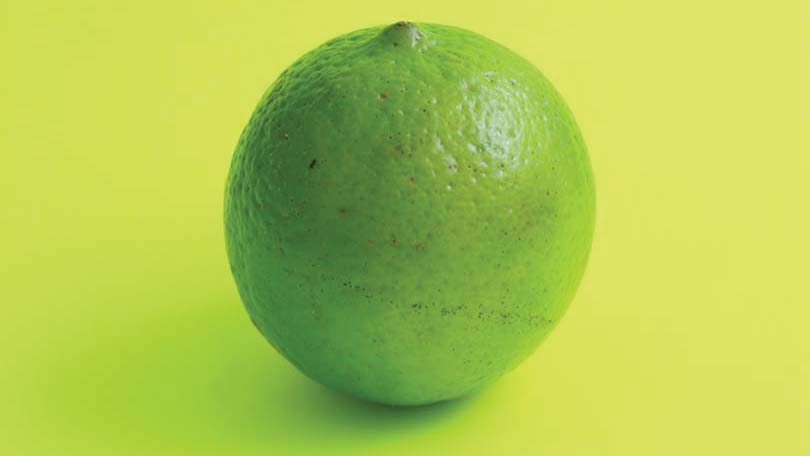Although rarely eaten fresh out of hand like most other fruits, the lime is highly valued as an ingredient in many food and drink recipes. Most parts of the lime – including the zest (peel), pith (white layer between the peel and flesh), juice, leaves, and flesh – play important roles in a variety of dishes in many cultures.
Limes favor tropical climates. It is thought that limes originally came from Southeast Asia, where Arab traders obtained them and returned them to Egypt and Africa in the 900s. Moors introduced limes to Spain in the 1200s, and then the fruit was disseminated throughout Europe during the Crusades. Columbus brought limes to the Caribbean on his second voyage to the New World. They were subsequently cultivated in the Florida region by Spanish explorers. Today, the leading lime producers include the United States, India, Italy, Mexico, and Spain.
Limes are available year round, although they are in their peak season from May through October. The two varieties of limes used most prevalently are the larger Persian (known also as Tahitian or Bearss) and the smaller Key (known also as Mexican or bartender’s).
When selecting a lime, look for one that is brightly colored, glossy, blemish-free, and glossy. It should be heavy for its size, and firm but springy to the touch.
Limes will keep their fresh flavor if kept at room temperature for up to one week, or loosely wrapped in the refrigerator for up to one month.
If you are juicing the lime, bring it to room temperature first; a warmer lime will produce more juice. Then, applying moderate pressure with your hand, roll it on the counter prior to juicing; this will release even more juice. If you want to store the juice for future use, you can freeze it in ice cube trays, and keep them in zip-loc baggies for up to four months.
One interesting bit of trivia is that the nickname “limey” originated from the 1800s, when British sailors were issued a daily ration of limes because the fruit’s high concentration of vitamin C prevented scurvy. (They didn’t actually know why or how it worked until 1923, when the health benefits of vitamin C were discovered.) In addition to their antioxidant-rich abundance of vitamin C, limes also contain cancer-fighting limonins.
Lime juice is popular in many beverages, including nonalcoholic drinks such as limeade, as well as cocktails such as margaritas. Many commercial carbonated beverages feature lime as the predominant flavor. Limes are also a popular garnish, either as a twist (as in a gin and tonic) or as a wedge (often served as an accompaniment to Mexican beer).
Like the juice of lemons, lime juice prevent oxidation and therefore can be sprinkled on fresh-cut fruit to prevent it from browning. Its chemical properties also make it a valuable addition to marinades. Lime juice serves as a wonderful salt substitute for people who are regulating their sodium intake. Its piquancy enhances the flavor of many foods.
Of the myriad lime recipes enjoyed around the globe, one of the most popular desserts is Key Lime Pie, which was developed after sweetened condensed milk was introduced to the Floridian Keys in the 1850s.
Key Lime Pie
For crust:
1 ¼ cup Nilla Wafer crumbs
1/3 cup brown sugar
6 tablespoons butter, melted
For filling:
4 egg yolks (reserve whites for meringue)
14 ounce can sweetened condensed milk
½ cup key lime juice
½ teaspoon cream of tartar
For meringue:
4 egg whites
¼ teaspoon cream of tartar
pinch of salt
½ cup granulated sugar
Combine crust ingredients in a bowl. Mix well. Press firmly into a pie plate to form a crust.
Bake crust at 350 degrees for 10 minutes until lightly browned. Cool on wire rack.
Beat the egg yolks until they appear pale yellow.
Stir in the sweetened condensed milk, lime juice, and cream of tartar.
Spoon into crust and bake at 325 degrees for 10 to 15 minutes, until filling is set.
Cool 15 minutes on a wire rack.
Freeze for at least three hours.
Beat egg whites, cream of tartar, salt, and sugar until stiff peaks form.
Spread meringue over pie, creating peaks and sealing edges to crust.
Bake at 350 degrees for about 15 minutes or until meringue is golden.






